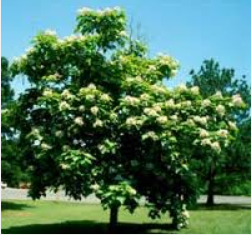Elaeagnus angustifolia Russian olive 50 years. Synonyms Catalpa syringaefolia Catalpa catalpa.
 Northern Catalpa Tree On The Tree Guide At Arborday Org
Northern Catalpa Tree On The Tree Guide At Arborday Org
If you have a lush lawn youll be happy to know turfgrass will survive under the chitalpa canopy.

What is the lifespan of a catalpa tree. Cercis canadensis redbud 40 years. Northern Catalpa Catalpa speciosa Warder ex Engelm By David Taylor. Continue to monitor your trees and have them periodically evaluated for declining health or safety hazards.
Common names for this tree are many and colorfulincluding cigar tree Indian bean tree catawba caterpillar tree hardy catalpa and western catalpa. Southern catalpa has an average lifespan of 100 years. Catalpa is a North American Indian name.
Northern catalpa is more widely planted than the southern catalpa Catalpa bignonioides. Cornus florida flowering dogwood 30 years. Award-winning Catalpa speciosa Northern Catalpa is a large deciduous tree adorned with a narrow oval crown and spreading branches clothed with huge heart-shaped light green leaves 12 in.
First cultivated in 1754 the wood was used for fence posts and railroad ties because of its resistance to rot and the trees fast growth rate. The deciduous plants are hardy to USDA planting zones 4 to 8 and can tolerate moist soils but are more suited to dry areas. Diospyros virginiana persimmon 60 years.
What is a Catalpa Tree. It is a larger and narrower tree than the southern catalpa and its pods are longer and stouter. Celtis occidentalis northern hackberry 80 years.
Catalpa trees are 40- to 70-foot 12 to 215 m tall trees with arching canopies and an average lifespan of 60 years. Other plants in the family include trumpet creeper Campsis radicans and crossvine Bignonia capreolata. Plant a chitalpa tree if you want a small flowering accent tree for your yard.
Catalpa trees grow for 50 to 150 years. Usually caused by heat or drought. The catalpa tree is found in forests from southern Illinois and Indiana to western Tennessee and Arkansas.
Species in this family range from woody vines to large trees. The deciduous plants are hardy to USDA planting zones 4 to 8 and can tolerate moist soils but are more suited. Dig a hole twice as deep and twice as wide as the root ball.
Family Bignoniaceae Genus Catalpa are deciduous trees of spreading habit with handsome large leaves and erect panicles of showy bell-shaped flowers in late summer followed by persistent slender bean-like seed capsules. What is a Catalpa Tree. Talk to your arborist about continued maintenance for your trees.
50150 years depending on conditions Also how do you care for a catalpa tree. The deciduous plants are hardy to USDA planting zones 4 to 8 and can tolerate moist soils but are more suited to dry areas. In late spring to early summer ravishing clusters of trumpet-shaped white flowers 2 in.
It also has larger leaves and its flowers open about two weeks earlier than those of southern catalpa. Catalpa trees are 40- to 70-foot tall trees with arching canopies and an average lifespan of 60 years. The oldest living Northern Catalpa is registered with Monumental Trees at 150 years old.
The Southern Catalpa trees lives approximately 70 years. These tree fungi are heartwood rotters of catalpa that enter through wounds. When severe the leaves turn yellow and drop.
Catalpa trees are 40- to 70-foot 12 to 215 m tall trees with arching canopies and an average lifespan of 60 years. Choose a bright sunny location for growing Catalpa trees. The family is mostly tropical and subtropical.
Catalpa tree species grow best in full sun and are adaptable to growing in various soil types. Fluff out the roots to the edges of the hole and fill in around them with well. Avoid wounding and keep the tree in good condition by fertilizing and watering.
Catalpa speciosa northern catalpa 75 years. Verticillum wilt will make the branches die and can eventually kill trees. What is the lifespan of a catalpa tree.
Both species live a long time. See section on Pecan Diseases Leaf Scorch. The tree is more than 125 years old now and though the catalpa is by no means anywhere near as long-lived as other tree varieties we expect it.
03 06 m per year. The leaves are arrow-shaped and glossy bright green. Ideally the soil should be moist and rich although the plant can tolerate dry and inhospitable sites.
Catalpa trees are typically fast-growing trees that grow between 1 and 2 ft. The mature height of catalpa trees is usually around 50 ft. Fagus grandifolia American beech 125 years.
Across 5 cm with abundant yellow stripes. The white flowers are bell-shaped and have two lips landing pads with yellow bands directing pollinators to the nectaries. Your trees will require several years to adjust to the injury and environmental changes that occur during construction.
They are glossy on top and densely hairy on their undersides. Trunk Rots fungi Collybia velutipes Polyporus versicolor and Polyporus catalpae. Stressed trees are more prone to health problems such as disease and insect infestations.
Northern catalpa is a member of the Bignoniaceae the Bignonia or Catalpa family. Powdery mildew causes a white powdery coating on the leaves. Catalpas have soft brown.